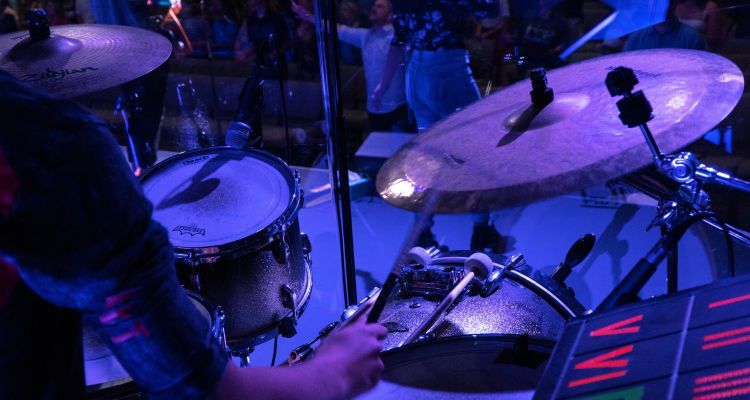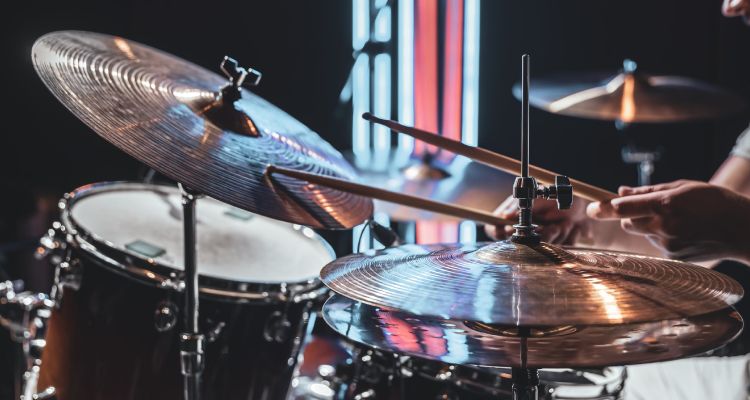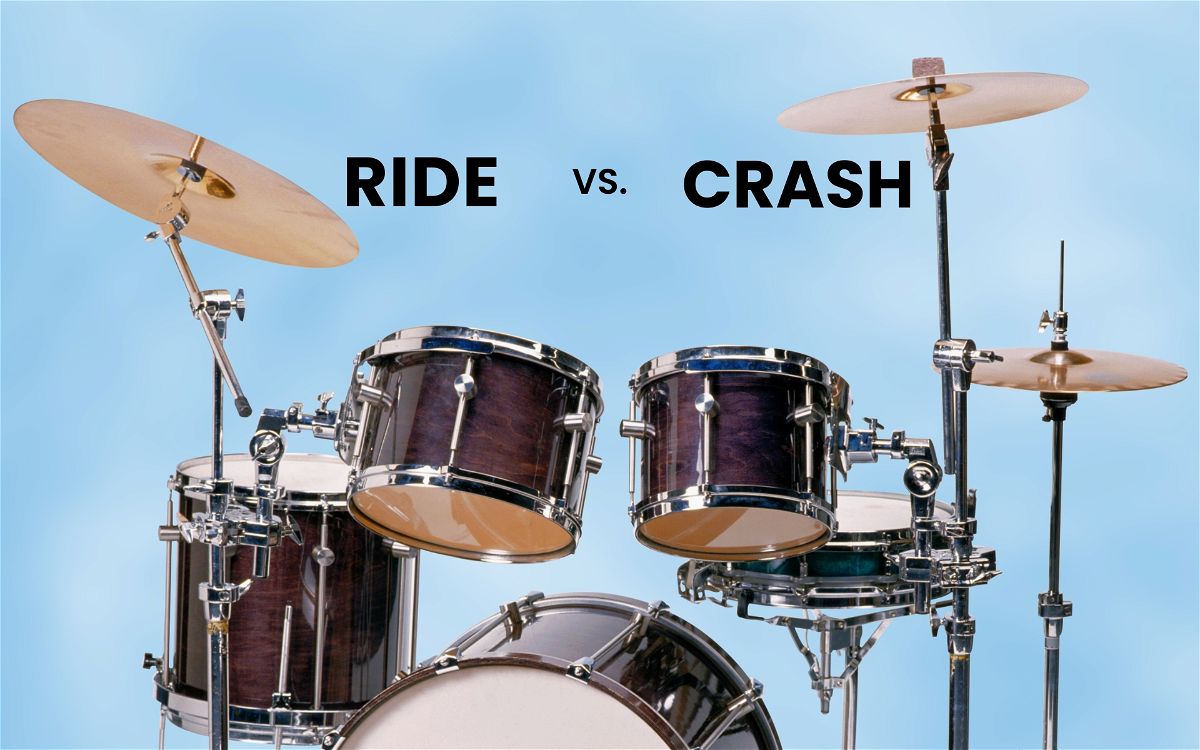There are several different varieties of cymbals that drummers use when setting up their kit, depending on their technical preferences and the musical genres they predominantly play.
Along with the hi-hats, there are two cymbals that are almost guaranteed to be found in a drummer’s set – crash, and ride cymbals.
Used in every playing style from jazz to metal, crash and ride cymbals are an integral part of most drummers’ setups and can be used for a range of purposes, from accenting certain beats to keeping the pulse of a piece of music.
In this guide, we’ll discuss the main differences between the ride cymbal and the crash cymbal, from their tonal and dynamic qualities to their physical attributes, suitability for certain styles and techniques, and more.
Contents
Ride Cymbal vs Crash Cymbal
Although these two main types of cymbals are pretty evenly matched in terms of their popularity, there are several significant differences between them that impact the way they sound and how they are used by drummers.
Let’s compare the most important aspects of ride and crash cymbals.
Materials and Size

The first notable difference between crash and ride cymbals is found in their physical attributes. Ride cymbals are visibly larger than crash cymbals. They are thicker and heavier too.
In terms of materials, crash and ride cymbals are most commonly made from the same bronze alloys – copper and tin. They may also include some small traces of other metals like silver. Nearly all professional cymbals are made of B20 bronze.
But when it comes to the size of these two cymbal types, it’s very easy to tell them apart. Crash cymbal sizes are generally between 14”-20” in diameter, while standard ride cymbal sizes range from 20”-24” in diameter.
It’s important to note that there are variations of crash and ride cymbals, which can be larger or smaller than the aforementioned size ranges, but these are less common and used for more niche styles or results.
Ride cymbals tend to be much thicker than crash cymbals, which lends them to producing a shorter, more articulate sound when played with the tip of the drumstick. Crash cymbals are thinner, which means they can easily produce their loud, distinctive crash sound when struck.
Tone
The tonal qualities of crash and ride cymbals are significantly different from one another. The name “crash” is basically an onomatopoeia of the general sound that this cymbal produces, while the ride produces a softer and more articulate sound when played with the tip of the drumstick.
Crash cymbals have an explosive, crashing sound when struck. It generally takes longer for them to decay after being struck by a drumstick. If played with power, crash cymbals can easily sound harsh due to their volume and tonal frequencies
Ride cymbals have a shorter decay which gives them more of a percussive, rhythmic sound than crash cymbals. They are rich in the midrange and treble frequencies, and when struck in the center, they create a bell-like sound.
However, if you listen carefully, you’ll notice that a ride cymbal produces overtones that continue long after the cymbal is struck – so technically, they sustain for longer than crash cymbals, but the frequencies are less noticeable.
The sound of both cymbal types can be altered dramatically depending on the part of the drum that you hit and the velocity with which you play.
Dynamics
Due to their increased size, ride cymbals are likely to reach louder volumes than crashes if you really dig in and hit the perimeter of the cymbal with your stick.
If you’re playing the ride in a conventional way by hitting the top with the tip of your drumstick, it’s more difficult to match the overall volume of a crash cymbal.
A general rule of thumb is that thicker cymbals with larger diameters will produce louder overall volumes. Smaller cymbals have a faster attack, with a reduced decay, so the sound is shorter-lived.
Position

A conventional right-handed drum set usually has the crash cymbal placed to the left of center from the drummer’s perspective, in the space between the hi-hat and the snare drum.
On the other hand, the ride cymbal is placed on the right side of the drum set, on the outer side of the floor tom.
These positions can vary slightly depending on the preferences of the drummer or the layout of their other drums. Some drummers choose to use multiple crash cymbals and therefore place another on the opposite side of the set, in the space between the rack and floor toms.
The reason that the crash cymbal is commonly placed on the left side of a right-handed drum set and vice versa is that it’s commonly used to replace one beat on the hi-hat in order to mark the start of a new bar or accent a particular beat in a song.
The ride is commonly used in place of the hi-hat to keep the backbeat of the music and, therefore, can be placed at a greater distance from it.
Playing Techniques
Drummers employ very different playing techniques when performing on both the crash and the ride cymbals.
A drummer plays a crash cymbal by striking it with the shoulder of the drumstick to produce a loud and explosive sound. Alternatively, a ride cymbal is played with the tip of a drumstick on the main top playing surface or bell.
The crash cymbal is predominantly used to signify the start of a new bar, and is typically played after a drum fill. The crash cymbal may also be used to emphasize a beat that isn’t at the start of a new bar, perhaps to accent a part played by another instrument in a band.
Ride cymbals are mainly used to keep the beat of a piece of music as an alternative to the hi-hat. Drummers often play quarter notes, eighth notes, or sixteenth notes of the ride, along with their kick and snare when playing a groove.
Hitting the bell of the ride cymbal with the shoulder of the drumstick produces a louder and thicker bell-like percussive sound, and this is often used for off-beat or syncopated rhythms to provide variation.
The crash cymbal is also sometimes used to keep the beat in the same way that the ride and hi-hats commonly do. Genres like garage rock, indie rock, and metal utilize the powerful sound of the crash in this way.
Durability and Longevity
Out of all of the cymbals used by drummers, the crash is the most prone to cracking, due to the aggressive way in which it is struck. Small cracks can appear either on the edge or along the grooves of the cymbal.
This happens to crash cymbals much more often than ride cymbals for two reasons. Firstly, they’re thinner, and secondly, they are often struck on the perimeter repeatedly with the shoulder of the stick, causing small fractures which develop into full-blown cracks.
Ride cymbals can also be damaged if they’re dropped or knocked over onto a hard surface, but they tend to withstand physical contact much more resiliently than crash cymbals do.
To prevent crash cymbals from cracking, it’s important to play them with proper technique. Try to employ a ‘glancing blow’ technique by striking across the edge of the cymbal rather than thrashing straight down.
Using specifically designed cymbal bags and cases to store your cymbals in when they are not in use is also a great preventative measure you can take to boost their longevity and save you money in the long term.
Musical Styles

Whether you’re a blues, pop, or jazz fusion drummer, you’ll likely incorporate crash and ride cymbals as part of your cymbal configuration. These two cymbals have been a staple of acoustic drum sets for many decades due to their versatility and effectiveness.
Jazz drummers use their cymbals differently to most other styles. The jazz ride is the most important cymbal and is used to keep the pulse of a jazz piece, by playing swung and syncopated rhythms. It’s also often used in jazz drum solos.
The ride cymbal is often played louder while comping to highlight certain notes, beats, or parts of a melody.
In rock music, the ride and crash cymbals have always been integral to the overall sound. In this style of drumming, power, and volume are important qualities, and these two cymbals can enhance them instantly.
Metal drummers, who often play with explosive speed and technicality, rely heavily on crash cymbals to provide the loud and cutting aggression required to break through a mix.
In pop music, the crash is used sparingly to mark the start of a new bar, while the ride is often used as an alternative to the hi-hat in the chorus of a song.
Frequently Asked Questions:
What is a Crash Ride Cymbal?
A crash/ride cymbal is essentially a hybrid that combines some of the qualities of a crash cymbal with those of a ride cymbal. The crash ride is commonly between 18” and -22” in diameter and is placed on the right side of the set.
Drummers may choose to use a crash-ride cymbal in place of their ride, as it can be used to a similar effect.
What is a Cymbal Choke?
A cymbal choke is where a drummer grabs their cymbal to stop it from decaying and mute the sound. This can be done for several reasons but is usually used to prevent the sound of the cymbal from interfering with other instrument parts.









